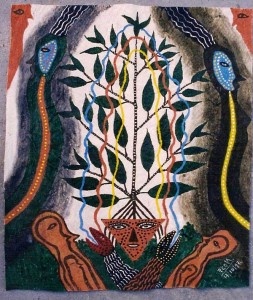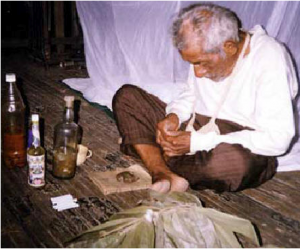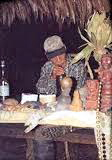Two rhythmic instruments are used in shamanic performance in the Upper Amazon — the shacapa, the leaf-bundle rattle; and the maraca, the seed-filled gourd rattle. Whether shacapa or maraca, rattles are the most important shamanic tool in the Amazon — the equivalent of the shaman’s drum elsewhere. Anthropologist Lawrence Sullivan, in his work on the history of religion in South America, calls them the paradigm of sacred sound, the epitome of the link between sacred sound and shamanic power; ethnographer Alfred Métraux descibes them as the most sacred object among the tropical tribes of South America; anthropologist Jacques Chaumeil says that, among the Yagua, the rattle is held to be the voice of the spirits. As my teacher doña María Tuesta put it, in her typical way, “My shacapa is my pistola.”
 |
| Fransisco Montes Shuña, The Wind of the Shacapa |
Mestizo shamans use the shacapa exclusively. Other Amazonian peoples use leaf-bundle rattles as well — for example, the Aguaruna, who use a rattle of sampi leaves; the Shuar, who shake a bunch of shinku leaves; the Yagua, who use a rattle of chacapa leaves; the Napo Runa, who use a huairachina bundle; and the Akawaio, who in fact abandoned the seed-filled gourd maraca in the mid-1950s in favor of “shaman’s leaves.” Anthropologist Stephen Hugh-Jones has reproduced an illustration from a health booklet published in Tukanoan by the Colombian government, which shows Tukanos, holding crosses, lined up for the healing of tuberculosis before a shaman shaking two leaf bundles.
The shacapa used by mestizo shamans is a bundle of leaves from the shacapa bush (Pariana spp.) tied together at the stem with fibers from the chambira, fiber palm (Astrocaryum chambira). Mestizo shamans reportedly also make leaf-bundle rattles from the leaves of carricillo (Arthrostylidium spp.), albaca, wild basil (Ocimum spp.), and achiote, annatto (Bixa orellana). In any case, my teacher, don Roberto Acho, was very specific about the plant he wanted for a shacapa when I would go with him to find the leaves.
 |
| Don Julio Gerena Pinedo with his shacapa, at the age of 89 |
The word has become an Amazonian Spanish verb — shacapar, heal by rattling. When don Roberto initiated my other teacher, doña María Tuesta, already a plant healer, into ayahuasca shamanism, two of the key things she learned were shacapar, healing and protecting with the leaf-bundle rattle, and soplar, healing and protecting by blowing mapacho, tobacco. Indeed, blowing, rattling, and singing are synergistic modes of sound; elsewhere in the Amazon, too, tobacco, rattle, and song are mythologically interconnected. Among the Makiritare of the Orinoco Valley in Venezuela, Nadeiumadi, a messenger or emanation of Wanadi, the heavenly creator, dreamed his mother into existence: “He gave birth to her dreaming, with tobacco smoke, with the song of his maraca, singing and nothing else.”
 |
| Don Ruperto Peña Shuña with his shacapa |
Among the Desana, the sound produced by the gourd rattle shaken by the shaman is said to echo the sound made by the thorns and splinters that the shaman carries hidden in his forearm. The rattle is thus a prolongation of the shaman’s arm; when he shakes the rattle, these thorns and splinters are shaken toward the victim. The sound of the Desana rattle is homologous with the phlegm of the mestizo shaman: both are the vehicles for the thorns and darts with which the victim may be harmed, the medium within which the projective power of the shaman is stored. It is the same with the mestizo shaman: the refined whispering, whistling, blowing, and rattling of the most powerful music is the same as the air-like presence of mariri, the most refined form of phlegm. Among the mestizo shamans, the wordless rhythmic rustle of the shacapa — like the breathy whistle of the song, or the almost silent whispered blowing of tobacco smoke — approaches pure sound.
There is thus a continuum of sound from the concrete, verbal, and intelligible at one end to the abstract, sonic, and unintelligible at the other. The continuum begins with intelligible lyrics in castellano, Spanish, and progresses through non-Spanish but human language such as Quechua; purported languages of indigenous people and unknown archaic tongues; the languages of animals and birds and computers; pure vocables; whispered sounds; whistling; breathy whistling; the silent pshoo of the blowing of tobacco smoke; and the susurration of the shacapa. The rarefaction of sound parallels the rarefaction of the shaman’s phlegm, from gross physical flema in the chest to abstract protective air-like mariri in the throat. The more rarefied the sound, the farther it departs from the materiality of intelligible words, the closer it comes to the state of mariri, the most rarefied phlegm in the sound-producing throat of the shaman. Both converge in a state of puro sonido, pure sound, which is the language of the plants.

- Previous Post: Three Ceremonies
- Next Post: Khadak
- More Articles Related to: Shamanism, The Amazon



In my my experience among the Ziona and cofan in Colombia the fan is called wayra which I believe caa be translated into “aire” or wind. This fan has the same uses that the Muvieri for the Huichol and the Loose Fans of the NAC, both as a “pistola” or a surgical device and to enhance and accompany the songs proper to the ceremony.
This is very fascinating, and reminded me of the branches with leaves that the Miko (the ancient Japanese Shinto Shamaness) would use when she was performing, Kami oroshi—-conjuring up or summoning the Gods.
I really enjoy your articles by the way.
Oh yes—-it must be a rattle and is therefore proof of Carl jung’s Collective Unconscious! (…I’m joking! I read your post on Jung’s Collective Unconscious, and while I am a fan of Carl Jung, your post was very thought provoking and interesting——I did not realize the controversy surrounding Schwyzer’s hallucination.)